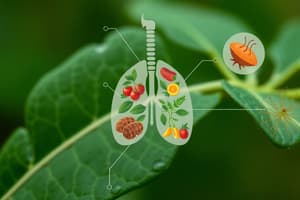Podcast
Questions and Answers
Compare and contrast aerobic and anaerobic respiration. What are the key differences in terms of oxygen use, energy production, and byproducts?
Compare and contrast aerobic and anaerobic respiration. What are the key differences in terms of oxygen use, energy production, and byproducts?
Aerobic respiration uses oxygen, produces more energy, and generates carbon dioxide and water. Anaerobic respiration doesn't use oxygen, yields less energy, and produces byproducts like lactic acid or ethanol.
How does the process of excretion contribute to maintaining a stable internal environment in living organisms?
How does the process of excretion contribute to maintaining a stable internal environment in living organisms?
Excretion removes metabolic waste, preventing toxic buildup and maintaining proper water and solute balance, which is crucial for homeostasis.
Explain how sensitivity is essential for an organism's survival. Provide one example illustrating the importance of sensitivity in avoiding danger or finding food.
Explain how sensitivity is essential for an organism's survival. Provide one example illustrating the importance of sensitivity in avoiding danger or finding food.
Sensitivity allows organisms to respond to stimuli, which helps them avoid danger and find food. Example: A deer detects a predator's scent (stimulus) and flees (response).
Describe the differences between asexual and sexual reproduction. What are the implications of these differences for genetic diversity within a population?
Describe the differences between asexual and sexual reproduction. What are the implications of these differences for genetic diversity within a population?
How do plants demonstrate movement even though they cannot locomote? Give two specific examples.
How do plants demonstrate movement even though they cannot locomote? Give two specific examples.
Explain why respiration is considered an essential life process for all living organisms.
Explain why respiration is considered an essential life process for all living organisms.
Describe some of the ways that animals show locomotion. Why is locomotion so important to animals?
Describe some of the ways that animals show locomotion. Why is locomotion so important to animals?
How does nutrition contribute to growth and energy production in living organisms?
How does nutrition contribute to growth and energy production in living organisms?
Flashcards
Movement
Movement
Changing position or moving internal parts.
Respiration
Respiration
Producing energy from food.
Sensitivity
Sensitivity
Detecting and responding to environmental changes.
Growth
Growth
Signup and view all the flashcards
Reproduction
Reproduction
Signup and view all the flashcards
Excretion
Excretion
Signup and view all the flashcards
Nutrition
Nutrition
Signup and view all the flashcards
Locomotion
Locomotion
Signup and view all the flashcards
Study Notes
- Life processes are the series of actions that are essential to determine if an entity is living
Movement
- Movement as a life process refers to an organism's ability to change position or location, or to move internal components.
- Locomotion is the movement resulting in a change of position.
- Animals show locomotion for reasons such as searching for food, escaping from predators, and finding mates.
- Plants show movement by growing towards sunlight or water, and by opening and closing their flowers.
Respiration
- Respiration is how living organisms produce energy from food.
- Aerobic respiration uses oxygen to break down glucose into carbon dioxide and water, releasing energy.
- Anaerobic respiration breaks down glucose without using oxygen, producing less energy and byproducts like lactic acid or ethanol.
- Respiration is essential for all life processes because it provides the energy needed for growth, movement, and other activities.
Sensitivity
- Sensitivity is an organism's ability to detect and respond to changes in its internal or external environment.
- Stimuli can be physical, such as light, temperature, and pressure, or chemical, such as odors and tastes.
- Responses range from simple reflexes to complex learned behaviors.
- Sensitivity is crucial for survival as it allows organisms to avoid danger, find food, and maintain a stable internal environment.
Growth
- Growth is the process of increasing in size and complexity.
- In unicellular organisms, growth is primarily an increase in cell size.
- In multicellular organisms, growth involves both an increase in cell size and an increase in the number of cells.
- Growth requires the synthesis of new proteins and other organic molecules.
Reproduction
- Reproduction is how living organisms produce new individuals of their own kind.
- Asexual reproduction involves a single parent and produces offspring genetically identical to the parent.
- Sexual reproduction involves two parents resulting in offspring genetically different from the parents.
- Reproduction is essential for the continuation of a species.
Excretion
- Excretion is the process of removing waste products from the body.
- Metabolic wastes include carbon dioxide, urea, and excess water.
- Different organisms have different excretory organs, such as kidneys, lungs, and skin.
- Excretion is important for maintaining a stable internal environment.
Nutrition
- Nutrition is the process of obtaining and using food.
- Autotrophs produce their own food through photosynthesis or chemosynthesis.
- Heterotrophs obtain food by consuming other organisms.
- Nutrients are substances that provide energy or are needed for growth and repair.
- A balanced diet contains the right amounts of carbohydrates, proteins, fats, vitamins, and minerals.
Studying That Suits You
Use AI to generate personalized quizzes and flashcards to suit your learning preferences.
Description
An exploration of essential life processes: movement and respiration. Movement involves changing position, while respiration generates energy from food. Aerobic respiration uses oxygen; anaerobic does not.




